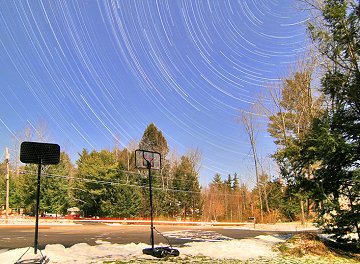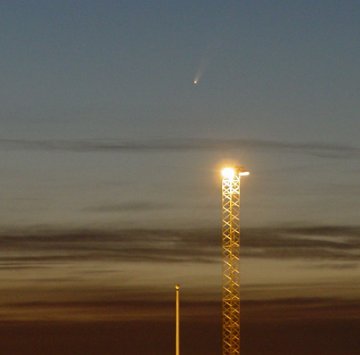 Did you sleep through the auroras of Dec. 14th? Next time get a wake-up call: Spaceweather PHONE.
Did you sleep through the auroras of Dec. 14th? Next time get a wake-up call: Spaceweather PHONE.
QUIET SUN: Two big sunspots are transiting the solar disk: image. Both are stable and quiet, posing no threat for flares or coronal mass ejections (CMEs). Solar activity should remain low this weekend.
BLUE SKY AT NIGHT: "Who says you can't take an interesting astro-photo under a full moon?" asks Larry Landolfi of Rochester, New Hampshire. In fact, he says, "you can," and as proof he offers this 3-hour exposure under the full Wolf Moon of Jan. 2nd:

Photo details: Canon 10D, Sigma 12mm lens, ASA 200, f/4.5, 90 x 2 min. exp.
The nighttime sky is blue! There's a simple explanation: The daytime sky is blue because molecules in the air scatter sunlight. The nighttime sky is blue because molecules in the air scatter moonlight. The physics is precisely the same. The blue of a moonlit sky is so faint, however, that a long exposure is required to reveal it.
Long exposures also make star trails--slow, graceful arcs traced by the stars as Earth spins on its axis. These are visible in Landolfi's photo, too.
HOT COMET: Comet McNaught (C/2006 P1) is plunging toward the Sun. It won't hit, but at closest approach on Jan. 13th it will be only 0.17 AU away--much closer than Mercury (0.38 AU). When the hot comet emerges later this month it could be brighter than a 1st-magnitude star. Or not. No one knows what will happen.
This weekend the comet is visible to the naked eye in the eastern sky just before sunrise. Veli Matti Pelttari of Rovaniemi, Finland, took this picture on Jan. 6th:

Photo details: Sony Cybershot, f/2.4, iso 100, 1 sec
Soon, the comet will be too close to the Sun to see--unless you're SOHO. From Jan. 11th to 15th, the Solar and Heliospheric Observatory will monitor the comet-Sun encounter using its onboard coronagraph. A date of note is Jan. 14th when Comet McNaught passes less than a degree from the planet Mercury. Join SOHO for a ringside seat.
More information: finder chart, ephemeris, 3D orbit.

